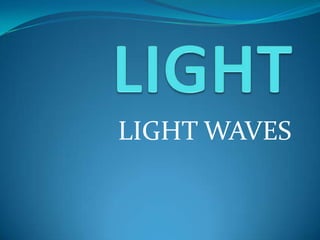
Light
- 1. LIGHT WAVES
- 2. Do you still remember Sir Isaac Newton? What about Christian Huygens? Did you meet them in your earlier grades? These people were the first to study about light.
- 3. What are the common sources of light? How do these common sources produce light? What are the common properties and characteristics of light?
- 4. Sir Isaac Newton believed that light behaves like a particle while Christian Huygens believed that light behaves like a wave. A 3rd scientist, Max Planck came up with what is now known as the Dual-Nature of Light. He explained that light can be a particle and can also be a wave.
- 5. To complete our knowledge about the nature of light, James Clark Maxwell proposed the Electromagnetic Theory of Light.
- 6. The Sun for example is known as a natural source of light. Sun is also considered as a luminous body (an object capable of producing its own light). Other sources are the lamps, bulbs, and candles. These are the artificial sources.
- 7. In your earlier grades you learned about energy transformation. Energy transformation is needed to convert or transform forms of energy to light or other forms. In bulbs, electric potential is converted to light. In lamps, chemical energy is transformed to light.
- 8. Spectrum Wheel Now that we are familiar with the electromagnetic spectrum and the corresponding energies, frequencies and wavelength probably we can see some applications of these in everyday living. UV rays are highly energetic than other spectral regions on its left. This could be a possible reason why we are not advised to stay under the sun after 9:00 in the morning.
- 9. Prolong use of mobile phones may cause ear infection. This may be due to a higher energy emitted by microwaves used in cellular phones than radio waves commonly used in other communication devices. What about the visible spectrum? Do you want to know more about this spectral region?
- 10. What are the frequencies and energies of the visible spectrum? This is the visible light. Sir Isaac Newton used a prism to show that light which we ordinarily see as white consists of different colors.
- 11. Dispersion is a phenomenon in which a prism separates white light into its component colors. Dispersion, a special kind of refraction, provided us color lights.
- 12. This phenomenon is observed when white light passes through a triangular prism. When white light enters a prism and travels slower in speed than in vacuum, color separation is observed due to variation in the frequencies (and wavelength) of color lights.
- 13. Light Light can only travel in a straight line/path. Since light travels in a straight line we get shadows. Speed of light: 300, 000 km/s (highest speed known in nature) 299, 792,458 m/s or 299, 792.458 km/s The farther from the source the lesser the brightness.
